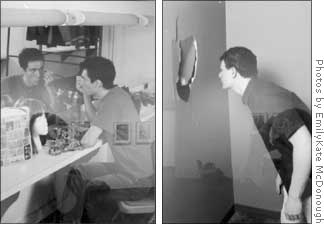
| << Front page | Arts | May 6, 2005 |
No, I Don’t Play Football falls short
Senior studio show seems fishy in
Fisher
 |
||
| Diva in drag: Rustin McCann-Piatetsky’s senior show documents his search for the meaning of masculinity. | ||
The first thing I saw when I walked into Fisher Gallery was the frame of a giant wooden box. Inside it were ripped pieces of drywall. On either side of the giant box, on two of the four walls of the gallery, hang black and white photographs juxtaposed by color prints. The prints and this frame belong to the senior show of studio art major Rustin McCann-Piatetsky, a show titled No, I Don’t Play Football. On the other two walls, another senior studio major, Mollie Hosmer-Dillard, displayed a variety of smaller paintings, several framed pieces of latex molded into belly buttons entitled Evidence of Birth and a corridor full of bark collected from a month-long meditation session in the woods.
In another corner of the gallery, an empty frame hung from the ceiling on two strings. A sign asked the viewer to stand behind the frame and imagine “oneself as art, and art as life,” a theme that seemed to underlie both McCann-Piatetsky’s and Hosmer-Dillar’s work. McCann-Piatetsky’s well-printed photographs do not visually capture his theme of the constructs of masculinity. Hosmer-Dillard was successful in conveying her theme that life experiences affect art. Unfortunately, Hosmer-Dillard’s works were overshadowed by McCann-Piatetsky’s imposing and visually incongruent art.
McCann-Piatetsky’s title, No, I Don’t Play Football, alludes to the fact that he looks more like a football player than the typical “scrawny art kid.” He exhibits four sets of photographs, each of which include a black and white print of himself juxtaposed with a color print of someone else in the “real world” posed similarly. McCann-Piatetsky’s topic is interesting – he attempts to explain to the viewer that because there is no singular model of masculinity, he must go on a quest to find his own concept of masculinity by exploring different male-gendered or male-identified peoples’ concepts of masculinity.
One of the most interesting photographs features a slender Asian man in front of a mirror, putting on eyeliner. The man, Kenichi, is a gay man well-known around Oberlin for performing in drag (see photo). This picture includes signifiers of drag performance such as a blue wig atop a mannequin’s head, hair spray and a few women’s scarves. In the photograph, Kenichi stares intently at himself in the mirror while applying eyeliner that, along with his other items, will eventually transform him into a diva. On its own, this photograph discusses various aspects of drag performance, the feminization of the Asian body and sexuality.
Unfortunately, this complex photo is overshadowed by the black and white photograph of McCann-Piatetsky in his white studio, peering through a hole in the wall. It could be he is trying to look through into the world of Kenichi, but visually the photograph does not make this connection. The viewer would have to assume that the space in-between the two photographs comprises one field of vision, even though the two photographs are clearly separated and compared. This leaves the viewer wondering why McCann-Piatetsky chose to make these two pieces separate when he could have made them one photograph discussing his confusion about the construction of gender. Instead, it looks as if McCann-Piatetsky is trapped in his own notion of himself as a man looking out of a hole into endless space.
Many similar photographs appear in the show, making the artist seem trite and narcissistic, or as if he has just had a major creative block. The color photographs of other people, however, leave the viewer with more questions concerning time, place, space and notions of masculinity. Juxtaposing the color prints with the black and white ones destroys the effect of the color photos on their own. As for the giant wooden frame in the middle of the gallery, the viewer can only hope that this is a metaphor for the deconstruction of masculine gender, though its purpose is not clear. Instead, the frame appears cumbersome and space-consuming in a show that already lacks clear presentation of visual evidence.
Mollie Hosmer-Dillard’s work explores different themes than Russ’s, and is obscured by the fact that the name of the show is No, I Don’t Play Football. Perhaps McCann-Piatetsky and Hosmer-Dillard did not coordinate with each other to come up with a joint title, but in any case, the name does not represent Hosmer-Dillard’s work at all. Dillard presents a number of paintings that discuss changing landscapes involving highways near her hometown in Missouri, experiences with nature and experiences pertaining to her body.
Her most interesting piece, “Evidence of Birth,” consists of framed pieces of latex molded into belly buttons. It is unclear whether or not Hosmer-Dillard refers to evidence of her own birth, or if these molds come from her friends and family members. In any case, the visceral nature of the latex connects the viewer to the work. The latex is colored like a white person’s skin, with a pinkish tone. This piece seems like a starting point for an idea upon which the artist has not yet expanded. Visually and tacitly, this piece opens a discussion of the body. It is through “Evidence of Birth” that the viewer gets a firmer grasp of the artist, while some of her other works merely discuss the notion of art as life and do not describe a clear personal experience.
This show is about two artists’ conflicting themes, yet the exhibit is
confined to one space. McCann-Piatetsky’s work is so imposing that it is
hard for the viewer to enjoy Hosmer-Dillard’s clever renderings. Her work
is placed on the walls with less visibility, suggesting that this show is more a
showcase for McCann-Piatetsky’s work than a collaboration between two
artists.
About us
Subscriptions
Advertising